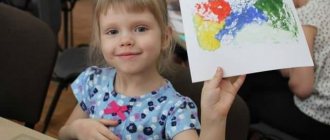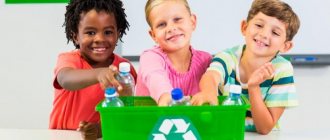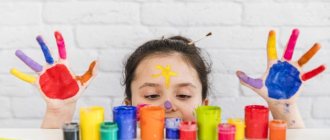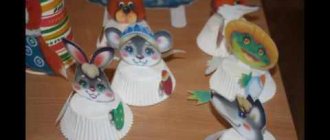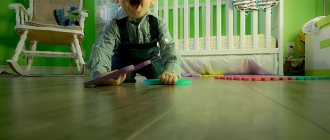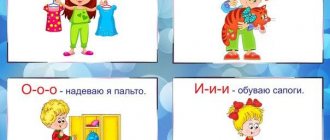Round table with parents in kindergarten. Sensory development. Abstract with presentation
Round table with parents on the topic: “Sensory development of children in kindergarten and at home using gaming technologies”
Purpose. Creating trusting partnerships between teachers and parents. Involving parents in the educational process of preschool educational institutions. Objectives: 1. Reveal the importance of sensory development in middle-aged children. 2. Show what games parents and children can play at home to consolidate acquired knowledge. 3. Promote the involvement of parents in updating PPRS in kindergarten. Event plan 1. Greeting, game “Tangle”. 2. Speech “The role of sensory development for middle-aged children.” 3. Game “Chamomile” 4. Presentation “Learning by playing.” 5. Play workshop “Do-it-yourself sensory toys” or master class for parents “How we play at home.” 6. Test task “Game in our family” 7. Reflection on the event. Equipment: a poster with statements by outstanding people, cards with the names of sensory standards, a chamomile “sensory education for a child is ...”, a ball of thread, a presentation “Learning by playing”, interactive games, a projector, a laptop.
Progress of the event
Introduction. Dear moms and dads! We are very glad to see you at our meeting, because we understand: without an alliance with children, without your support and help, raising children and creating a cozy and joyful environment for them in kindergarten is impossible. We hope that today we will have a good time. In order to relieve stress, we suggest playing the game “Greeting”. (Teachers and parents stand in a circle and greet each other with a handshake in a circle.) Then the game “Tangle” (Question: what is it?) - You verbally conveyed your sensory sensations, i.e. your tactile, visual sensations about this object. The role of sensory development in middle-aged children The initial stage of a child’s cognition of the world is his sensory experience, which accumulates most intensively in preschool childhood. Individual sensations received from an object are summarized into a holistic perception of it. Based on sensations and perceptions, ideas about the properties of objects are formed, it becomes possible to differentiate them, to single out one from many others, to find similarities and differences between them. If you underestimate the development of goal-directed perception, then children’s ideas about the subject are distorted, they become blurred and situational (a little training). How successfully and independently the child masters the system of sensory examination actions, allowing him to independently examine and examine objects to identify their features necessary to achieve results in a particular activity, determines the harmonious development of the child. The success of mental, physical, aesthetic education largely depends on the level of sensory development of children, i.e. depends on how completely the child hears, sees, touches the surroundings (examples: name the trees whose leaves are yellow or red in autumn). By screaming, a child can distinguish birds and animals. The level of sensitivity to sensory stimuli varies significantly among all of us, and how much it will be developed by school depends on you and me. What and how to teach a child? The first and main task is to provide the child with a wide variety of objects for examination and draw his attention to their properties. (which is what we did) But this is not enough for the full development of perception. The child must learn to determine the relationship of the identified or considered properties of a given object to other properties or objects (an example of a game in the family). There are special “measures” for this; the main efforts should be directed towards their development. These measurements are called “sensory standards.” “Sensory standards” are generally accepted examples of the external properties of objects. We adults possess sensory standards without thinking about them at all. A child can operate them with the same ease only by the age of five. (The teacher attaches cards with the names of sensory standards to the magnetic board: color, shape, hearing, taste, smell.) In order for the difference to be fixed in the child’s mind, it must be named, emphasized and repeatedly reminded of it, that is, play with the child (5 minutes ) Let's summarize: what importance does sensory education have for the cognitive development of a baby? Game “Chamomile” Parents were asked to write early on what sensory development is.
(Chamomile: middle “sensory education”, petals – “meaning”: - intellectual development, - prepares for real life, - develops observation, - develops attention, - has a positive effect on the aesthetic sense, develops imagination - organizes the chaotic ideas of the child obtained through interaction with the outside world, - the assimilation of sensory standards, - ensures the development of skills in educational activities, - speech development, - the development of logical thinking, - forms the ability to establish cause-and-effect relationships. When building work on sensory education, we teachers try to take into account the individual characteristics of each child, using a personality-oriented approach and building work on sensory education in stages, from simple to complex. Teachers try to build the entire educational process on a variety of games, exercises, activities, creating comfortable, favorable conditions for easy perception of the material.
Presenter. Let's play ( "communicative minute » ) Please stand in a circle: - those who have daughters - stretch their arms forward, - those who have 2 children - raise their hands up, - those who have sons - jump, - those who came today in trousers - sit down, - those who like ice cream - stand on one leg, - who likes to listen to music - put your hands on your belt, - who wants to go on vacation - take your seats. You see how simple the game is - and how much positive emotions it brings. Leading. Let's see what games your children play in kindergarten. Presentation “Learning by Playing”. Somewhere in the world there is a kindergarten like this. Children are running around in a cheerful crowd. And cute dolls are sitting on chairs, Only Pokemon are in the children’s hands. What will happen on this planet if children do not learn to play: As a kind mother, a hard-working father, As a doctor, a carpenter or a singer? After all, what children play still determines who they grow up to be... Game occupies a leading place in the educational process. And for this to happen, the child must be able to play. Play in the development of the personality of a preschool child occupies an exceptional place not only because it improves individual mental processes, but because “play raises the child’s personality, his consciousness to a new level of development. In play, a child becomes aware of his “I”, learns to act, subordinating his actions to the desired goal and determining them depending on the goal. The game, therefore, is a school of such activity in which necessity appears not as external, imposed from the outside, but as desired... It is a prototype of future serious activity...” Game workshop: parents tell “How we play at home” Test task “Game in our family” “ Remember evenings at home and give them an assessment:
- every evening I spend time playing with children, - I talk about my games in childhood, - if a game is broken or a toy is repaired together with the child, - do you think that playing together is beneficial for your child’s development? , - having bought a game for a child, I explain the rules of the game, show different options, - I listen to children’s stories about games and toys in kindergarten, - I do not punish the child by depriving him of a game or toy, - I often give the child a new educational game.
If you get more “yes” answers, then the game is always present in your home. Reflection on the event . Game "The Connecting Thread". Teachers and parents stand in a circle and pass the ball to each other, passing on their feelings about the event or wishes to each other.
Presentation on the topic: Learning by playing
We recommend watching:
Parent meeting on traffic rules in the preparatory group Creative workshop in kindergarten “Making laboratory materials with your own hands” Lesson with parents in kindergarten. Abstract Literary quiz on fairy tales for kindergarten
Similar articles:
Plan of interaction with families of children of the middle group of general developmental orientation
Methodological recommendations for drawing up an individual development program
MAGAZINE Preschooler.RF
“Round table “The Magic World of Books” as a means of improving the pedagogical culture of parents in the older age group”Completed by Elena Gennadievna Sarantseva, Educator, municipal budgetary preschool educational institution “Child Development Center - Kindergarten No. 87”, Samara City District Topic: “The Magical World of Books”
Form: round table
Audience: 18 parents of the older age group
Number of participants: 2 teachers, preschool psychologist, librarian.
Tasks:
- Expand parents’ ideas about the role of books in raising a child;
- Encourage parents' self-education;
- Instill reading culture skills.
Expected results: parents’ conclusion about the importance of the child’s interest in a children’s book, about its huge role for their comprehensive development.
Information and technical support:
- Exhibition of children's books and magazines
- Photo exhibition “We are a reading family”
- Selection of tips and consultations: “How to become a good reader” , “How your child handles a book” , “If you decide to buy your child a new book”
- Instructions “How to make a book” .
Materials and equipment:
- Slides “role-playing games “Bookstore” , “Library” , “Children of the group in the book corner”
- Presentation “Journey to the Book’s Past”
- Video “Children's Literary Quiz”
Preliminary work:
- studying the reading interests of children and clarifying attitudes towards reading books,
- preparation of an exhibition of multi-genre children's literature,
- selection of discs with recordings of poems, fairy tales, stories in artistic performance,
- Design of the folder “Read books to children!”
- Selection of tips and recommendations for parents
- Selection of material for the “Literary Quiz” with parents.
- Preparation of prizes for awards in the nomination “The Most Reading Family” .
Logic:
Educator: Good evening, dear parents! We are glad to meet you. The theme of our meeting is “The Magical World of Books” . Today we have to answer the main question: “What place does a book belong in the family education of a 5-6 year old child?”
Agenda:
- Speech by a preschool educational institution psychologist on the topic “The influence of children’s literature on the emotional development of a preschool child ,
- Speech by teachers with viewing of the presentation and slides “Introducing children to fiction in kindergarten .
- Literary quiz for parents “Find out a fairy tale” .
- Continuation of the teacher's presentation with a video showing a children's literary quiz.
- Speech by parents . ”
- Speech by the librarian of the city children's library.
- Final part.
- Speech by a preschool educational institution psychologist on the topic “The influence of children’s literature on the emotional development of a preschool child”
Our time is a time of great achievements in science and technology, a time of wonderful discoveries. But of all the miracles created by man, M. Gorky considered the book the most complex and great. The book contains the vast spiritual world of humanity.
“I probably won’t be able to convey vividly and convincingly enough how great my amazement was when I felt that almost every book seemed to open a window into a new unknown world for me . M. Gorky.
These words of the writer accurately reflect the desires of all adults to choose books for children that would answer all their whys. Without the help of adults, a child cannot enter the wonderful world of books.
Senior preschool age. From the age of 5, a new stage in the literary development of a child begins. The most beloved among children are magical Russian folk tales with their wonderful fiction, fantastic nature, developed plot action, full of conflicts, obstacles, dramatic situations, various motives (treachery, miraculous help, opposition to evil and good forces, and much more), with bright, strong characters. heroes. Russian folk tales ( "Morozko" , "Sivka-Burka" , "The Frog Princess" , "Sister Alyonushka and Brother Ivanushka" , and others). They open up space for the child’s feelings and thoughts about a complex world, where good and evil forces collide in an irreconcilable struggle, where children are confirmed in the indispensable, inevitable victory of good over evil, are surprised by miracles and secrets and try to reveal and comprehend them. At an older age, a child acquires the ability to understand text without the help of illustrations. Children are already able to understand events in the book that were not present in their own experience. The child develops the ability to perceive a literary work in the unity of content and form, comprehend the verbal image, and treat it as an author’s device. There also arises the ability not only to notice an expressive, bright word, but also to realize its role in the text.
Each piece of art for children contains different types of emotions. The child penetrates into the interaction of the characters and takes into account not only who performed the action, but also to whom it was directed. At this age, with the development of empathy and assistance to the hero, moral argumentation arises. For example, in the works of Lilian Moore “Little Raccoon or the One Who Sits in the Pond” , N. Nosov “The Living Hat” , S. Aksakov “The Scarlet Flower” , T. Shorygina “How the Serpent Gorynych Became Kind” we see joy, and fear, the ability to negotiate, to make friends. In the story by V. Kataev “The Flower - the Seven-Flower” , S. Lagerlöf “The Wonderful Journey of Nils with the Wild Geese” - empathy, sympathy. In the fable “The Dragonfly and the Ant” by Krylov there is fun, joy, hard work, sadness, surprise. In T. Shorygina’s work “The Glowing Car” there is a feeling of guilt, resentment.
We see such a complex feeling as sadness in the fairy tales of G.Kh. Andersen's "The Snow Queen" , "The Ugly Duckling" , T. Shorygina's "A Happy Day" .
To cultivate honesty and the ability to recognize lies, the following fairy tales were offered to children: “The Fox and the Goat” , “Little Fox and the Gray Wolf” , were L.N. Tolstoy “Bone” , “Liar” , “Cup” , Wigand Molly “Forget about fear” , A. Volkov “The Wizard of the Emerald City” .
Fairy tales describe the basics of a safe and creative life. Even just reading a fairy tale has an amazing effect and helps you overcome life's difficulties. Listening to works of art, a child accumulates in his subconscious, forming behavioral stereotypes.
2. Speech by teachers with viewing of the presentation and slides “Introducing children to fiction in kindergarten .
Throughout the preschool period, there is an active development and improvement of abilities to perceive literary works, the formation of interest and love for books, that is, the child is successfully developing as a reader. This circumstance forces us, teachers, to carefully consider issues related to reading books to preschool children and, above all, to the selection of works of children's literature for each age stage.
A thoughtful selection of books for children's reading is determined by what inevitably influences the child's literary development, the formation of his literary experience at the stage of preschool childhood, and the development of an attitude towards books. When introducing children to a literary work, the text is first read expressively. This part of the lesson is very important and responsible - here the child’s first encounter with a work of art takes place. Next is a conversation about what you read. Children easily engage in such a conversation with pleasure, because it meets their need to talk about what they read, share their impressions, and express their overwhelming feelings. During a conversation, it is useful to read individual fragments of the work. Such repeated reading helps children to catch and understand what might have been missed when first perceiving the text. During the conversation, the main idea of the work and its problem are revealed. We actively use our free time to significantly expand children’s literary knowledge and better introduce them to works of Russian and world literature.
Children love books and enjoy spending time in the book corner. Here the books are arranged by genre with conventional signs - pictures (fairy tales, poems, short stories, epics, encyclopedias, magazines and new items (books recently purchased)). This is how they get acquainted with fiction.
Demonstration of slides in which children look at and read books and share their impressions.
The group conducts a circle “Information Culture” , in which, with the help of presentations, children travel into the past of the book (demonstration of the presentation to parents with explanations).
And with the help of conversations and games, children learn that a book is a source of information (showing slides to parents about role-playing games: “Bookstore” , “Library” ).
3. Literary quiz for parents “Find out a fairy tale” .
To make it easier for us to communicate today and solve problems, let’s hold a literary quiz “Find out a fairy tale” .
Contents of the quiz: parents are given cards describing the fairy tale. After reading them, parents name the author and the title of the literary work.
- The hero of this fairy tale, meeting a hare, a wolf, a bear and a fox on the way, loves to sing his song (Russian folk tale “Kolobok” );
- In what fairy tale does a brave mosquito save the birthday girl from a villainous spider? (K.I. Chukovsky “The Cluttering Fly” );
- In which fairy tale did a mushroom save an ant, a butterfly, a mouse, a sparrow and a hare from the rain? (V. Suteev “Under the mushroom” );
- In this fairy tale, did the stove, apple tree and river help the children hide from Baba Yaga’s evil birds? (Russian folk tale “Geese and Swans” );
- This fairy tale is about a little girl who fit in a walnut shell, overcame all difficulties, saved a swallow from the cold, and found her happiness (H. H. Andersen “Thumbelina” ).
- Continuation of the teacher's presentation with a video showing a children's literary quiz.
Now look how your children answered the same questions in the “Find out a fairy tale” (video show).
5. Speech by parents “From the experience of family education .
Next, parents speak on the following issues:
- The book is in our family;
- Traditions of our family;
- Children's attitude towards books.
6. Speech by the librarian of the city children's library.
Our guest today is a representative of the city children's library.
The librarian draws the parents' attention to the content of the prepared meeting (popular science books for children, classical literature, books about nature, working people, collections of fairy tales, riddles, epics, etc.). Children need to be introduced to works of children's literature of various genres (poems, fairy tales, short stories, small folklore forms).
The content of the works should reveal all areas of the world around the child: “I myself” - about children, their emotions, feelings; “The World Not Made by Hands” is about nature; “Man-Made World” - about objects created by human hands; "The World of People and Human Relations" .
The librarian talks about what a book is, forms the basic requirements - how children need to handle it and how it needs to be taught (Showing photographs of the librarian’s visit to our group with a story about national holidays).
The most reading families are rewarded with collections of poems.
7. Final part.
Children who received the “book vaccination” in early childhood are incomparably better prepared for school. They know how to listen, focus on a specific activity, and speak well (L.N. Zelentsova). It is books that excite the mind, heart and imagination of children that help them understand difficult life situations, sharpen their sensitivity to good and bad, and encourage them to independently find the right answers to complex questions.
Parents are offered reminders with advice:
- How does your child handle the book?
- How to become a good reader?
- If you decide to buy your child a new book.
- Instructions “How to make a book” ?
Round table decision.
- Tell children about the children's library, sign up for it and regularly borrow books for family reading;
- Subscribe to a children's magazine;
- Read literary works of different genres to children every day;
- Regularly practice poems with children.
Applications.
Reminders for parents.
How does your child handle books?
By the way the books that belong to your child's house look, you can judge whether you are paying enough attention to your child's book handling skills. Pay attention to whether your child adheres to the following rules:
- Before you pick up a book, you need to check that your hands are clean.
- You can read and look at a book only at the table
- The book must be taken care of, do not get dirty, do not wrinkle the pages, do not play with the book, this will spoil it
- After you have looked and read, put it back in its place.
- The book must be stored in a bookcase or on a shelf
- If you notice that the book is not in order (the pages are torn), it needs to be repaired by asking adults for help.
If you decide to buy your child a new book.
When choosing books for your child, pay attention to the following qualities:
- How the book is illustrated
- Does the book match the child's listening abilities?
- Will your child like the book?
- Does the book have the power of emotional impact?
Although children also like those books that simply contain information, for a long time the child’s favorite books are those that are emotionally close to him.
5. Is the book well written? Children listen to the sound of speech, not just its meaning.
6. Do you like the book? If you read what you like best, you have more reason to expect that your child will like it.
How to become a good reader?
- Take as much from the book as you can. Remember that reading is one of the most important, necessary, serious and wonderful activities.
- Don't read a book with other things in mind. It's a bad habit to only look at books.
- If you encounter words or phrases in the book that are unclear in content, seek clarification from dictionaries, reference books, and encyclopedias.
- Write down the statements you like most.
- Read according to a specific system. It is very useful to read several books by the same author.
- Read aloud often. This develops expressive reading techniques.
- An indicator of a reading culture is the desire to reread books.
| Next > |
